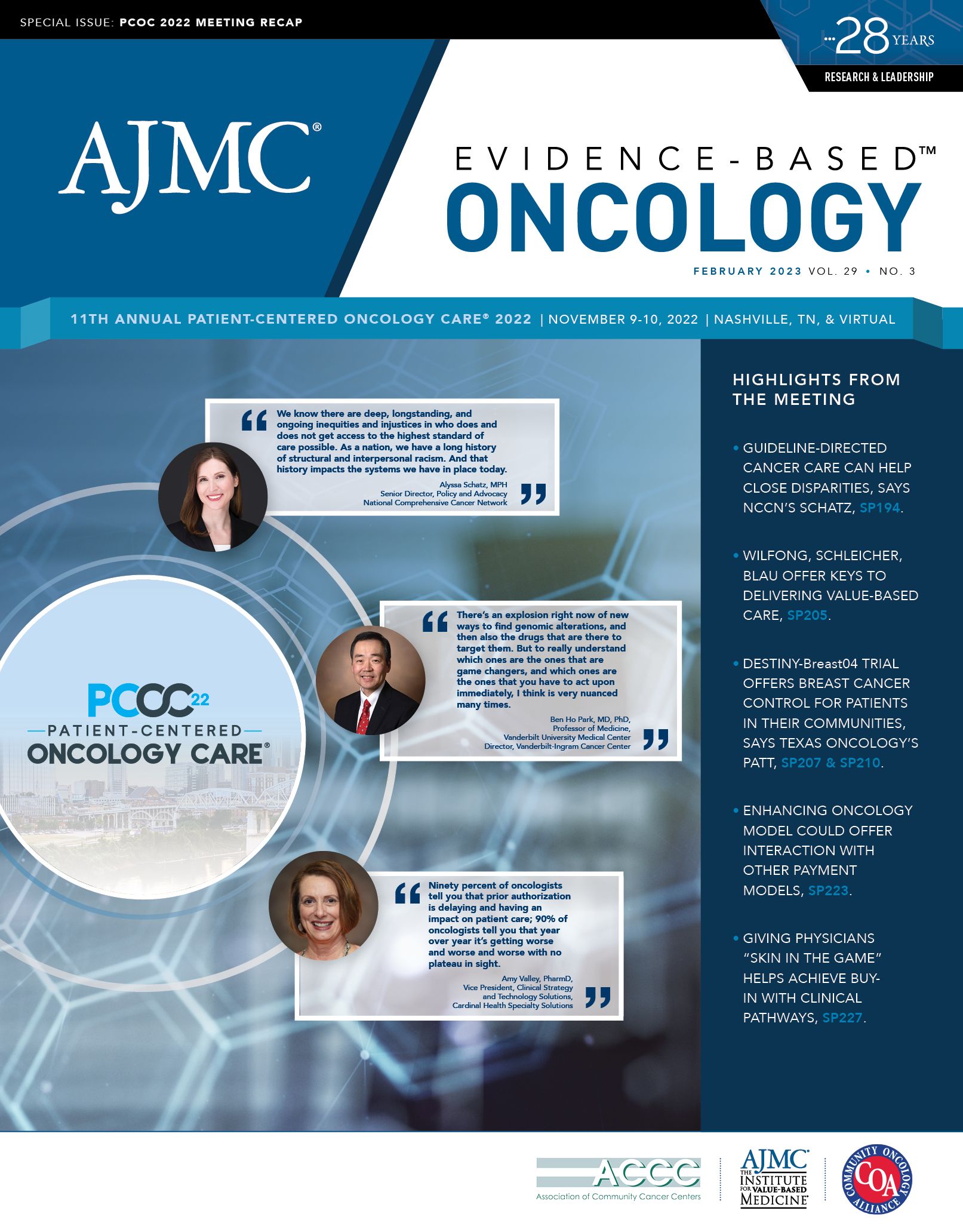Publication
Article
Evidence-Based Oncology
With Broad Input, Clinical Pathways Making a Difference for End Users
Author(s):
More than a decade after the first oncology clinical pathways appeared, these point-of-care tools have evolved to do more for the care teams who use them. Acceptance has increased, too, through efforts to give end users a role in their development. And that’s led to some interesting discussions about what information should and should not be included in pathways.
These were the takeaways from the discussion, “Why Clinical Pathway Adoption Is a Team Sport,” the final panel of the 11th Annual Patient-Centered Oncology Care® (PCOC) conference held November 9-10, 2022, in Nashville, Tennessee. Moderated by PCOC Cochair Joseph Alvarnas, MD, vice president for government affairs and senior medical director for employer strategy, City of Hope, the panel featured the following members:
- Karen Fields, MD, former medical director of clinical pathways and value-based care, Moffitt Cancer Center;
- David Jackman, MD, medical director for clinical pathways, Dana-Farber Cancer Institute; senior physician, Lowe Center for Thoracic Oncology; and assistant professor, Harvard Medical School;
- Edward Arrowsmith, MD, MPH, managing partner and director of research, East Tennessee Division, Tennessee Oncology; and medical director, clinical pathways, OneOncology; and
- David Debono, MD, national medical director, Elevance Health, an affiliate of Anthem.
Alvarnas asked each panelist for an overview of their current role in the pathways process and opened by mentioning that genomics and social determinants of health—which were only starting to hit the radar when the first pathways arrived—are expected to be considered in health care delivery. Can pathways take these things into account while keeping up with the furious pace of innovation?
Debono explained that the Elevance pathways panels include both academic and community oncologists, “about 50/50,” he said. A major goal of the process is to remain independent of commercial interests, and Elevance teaches providers about the pathways through a team of oncology nurses and pharmacists who work one-on-one with practices. It’s a model that not only offers regular updates about the pathways but also allows Elevance to collect regular feedback from end users, Debono said.
Both Moffitt and OneOncology developed pathways through internal processes; Fields started Moffitt’s program in 2009, while OneOncology’s initiative has come together over the past year. As Arrowsmith describes it, “Having an internal process had its own rewards,” by gathering input from 15 practices, building up “disease groups” based on expertise—which would serve the network not only for pathways but also for clinical trials. Just having this internal process, Arrowsmith said, “allows us to more readily integrate clinical decision support tools at the point of care.”
When Moffitt started its process, Fields said, clinical pathways offered a way to prepare for alternative payment models. It was important to be clear that pathways were a quality initiative, not a backdoor method to cut costs. Early on, she said, Moffitt developed its own internal electronic health record (EHR) beta product and its tool incorporated available clinical trials, which encouraged its use within the research organization. Rather than take away physician autonomy, Fields said, Moffitt’s tool has helped improve patient care as the number of therapeutic options increased. “With the explosion of new therapies and new targets, it’s changing so rapidly that it’s hard to keep up,” she said. “So, we really felt that what we would give them back is a tool that made their day easier.”
“Skin in the game.” Dana-Farber’s product, developed with Philips, now invites delegates from each of its member users to participate in the review committees that update the pathways, Jackman said. This aligns with a core tenet to getting physicians to use pathways content. “They’ve got to have skin in the game,” Jackman said. When physicians take part in the development of the product, he said, “They want to make something that is going to work in their own practices and in the practices of other physicians using it.”
Getting physicians to take part in the pathway committees has not been an issue. Jackman said it’s the second part—translating that participation into use of the pathway tool during a busy day in practice—that is the challenge. It’s a matter of engaging physicians in the ideas, not just how many seconds a pathway tool can shave off their workflow. Does the product embed meaningful consent forms, treatment plans, and other information that they can now have at their fingertips in real time?
Arrowsmith agreed that “physicians love to be in charge” and that getting the tool used at the point of care is the challenge. For example, he said, pathways developers must consider how to make tools as efficient as possible for the lung cancer specialist who knows exactly which therapy he wants but now sees 100 different options. OneOncology, Arrowsmith said, has collaborated with its vendor, Flatiron, to develop Flatiron Assist to make the process as smooth as possible.
Genomic information. Incorporation of this information over time allows for success stories because as the FDA approves new therapies for new targets, oncology practices can now search through patient records to find patients who are eligible for a treatment that now offers a better option. Arrowsmith offered an example of an oncologist in a solo practice who had a lung cancer patient ready to start on a standard chemotherapy, but the EHR and the pathway showed that patient had a KRAS G12C mutation, and the oncologist was able to switch to a newly approved therapy before chemotherapy began.
Working as a team. Although many pathways have been focused on therapeutics, Fields said, “We also made our pathways multidisciplinary because we all know that cancer is a multidisciplinary team sport.”
Thus, the pathways team can include clinical pharmacists, surgical oncologists, radiation oncologists, and other team members—such as data informatics specialists—who assemble the information and ensure the pathways are constantly updated and integrated with the EHR so everything reaches the teams in the clinic. “We have a biostatistician assigned to us, to be able to look at outcomes and link things together,” Fields said. “Giving that feedback to the teams is critical for utilization.”
The patient’s voice. Alvarnas asked for input on a highly discussed issue within the CMS: how to incorporate patient feedback—including information on both drug and financial toxicity—into the decision-making process and, possibly, into the reimbursement process. Both Jackman and Fields said the answers are not always so obvious. Jackman said the Dana-Farber group discussed whether to incorporate patient out-of-pocket cost information into the EHR. But based on feedback from a patient and family advisory council, they opted against this change. According to Jackman, the advocates said, “We worry that it might create different standards of care; that doctors—whether intentional or not—might make assumptions about what a patient can or would want or could afford, and that doctors might then choose the cheaper thing without actually addressing it with the patient.”
The decision was that if cost information were included, it had to be made available to the patient as well, Jackman said.
As for adverse events (AEs), such as nausea, Fields said the question is whether the physician wants to know those things upon prescribing the drug and deal with them up front. Moffitt, Fields said, has created an entire group focused on dealing with AEs with a goal of running parallel with the pathways program. As for financial toxicity, she said, “Our pathways program can help identify which patients might want to focus on purchasing toxicities or other kinds of issues” so that the clinician will know to refer that patient to a financial counselor.
When it comes to electronic patient reported outcomes (ePROs), Fields said it’s not clear that ePROs have reached the point where clinicians believe they are “accomplishing what we wish it will accomplish, which is taking patient feedback at the point of care and acting on it.”
The value proposition. With health systems and payers making “enormous investments” in the development of pathways, Alvarnas asked Debono: “What do you see as the value proposition around these pathways and treatment guidelines? And where does cost figure into the value proposition?”
Debono said developing a pathway is hard work but it replaces the need for busy clinicians to individually troubleshoot the literature, understand individual clinical trial designs, and “arrive at a value orientation.” As for cost, he said, “I think most clinicians don’t really know the cost of many drugs, particularly some of the new drugs.”
“So the work entailed to arrive at a value-oriented pathway, I think, does add some value to the busy physician and the busy practice,” he said. “The issue of cost is certainly a controversial one. But I think all of us here in this room understand the difficulty in the cost of medical therapeutics, particularly in oncology, and so our panel spends most of their time talking about efficacy and toxicity of new drug regimens. Because that’s really where the action is.”
There are scenarios, he said, where clinicians can arrive at multiple drugs or regimens that are “relatively equivalent” and then, “Cost does come into the conversation.” Toxicity of one drug over another may also be an issue, he said.
“And you’ll notice in some of our pathways, if maybe some of the branded drugs are not on our pathways—even though they’re readily reimbursed—there’s no obstacle to reimbursement for those drugs, but they may not arrive at a true value orientation.”






